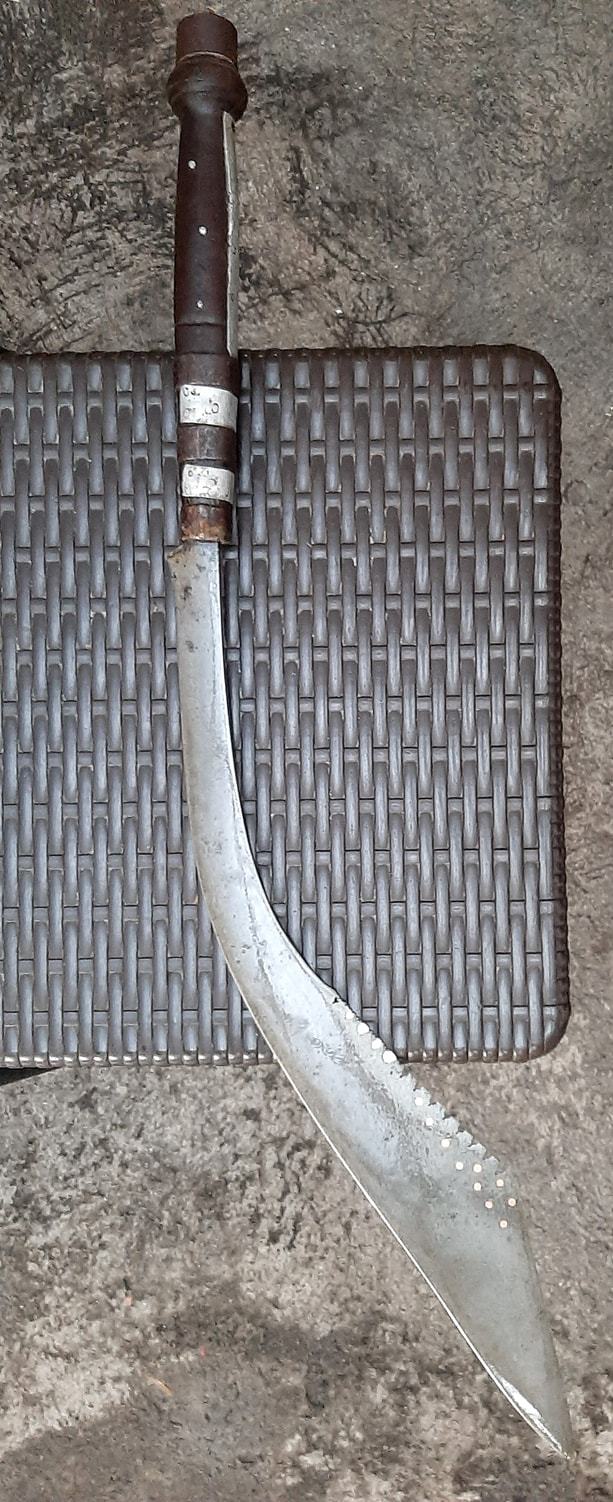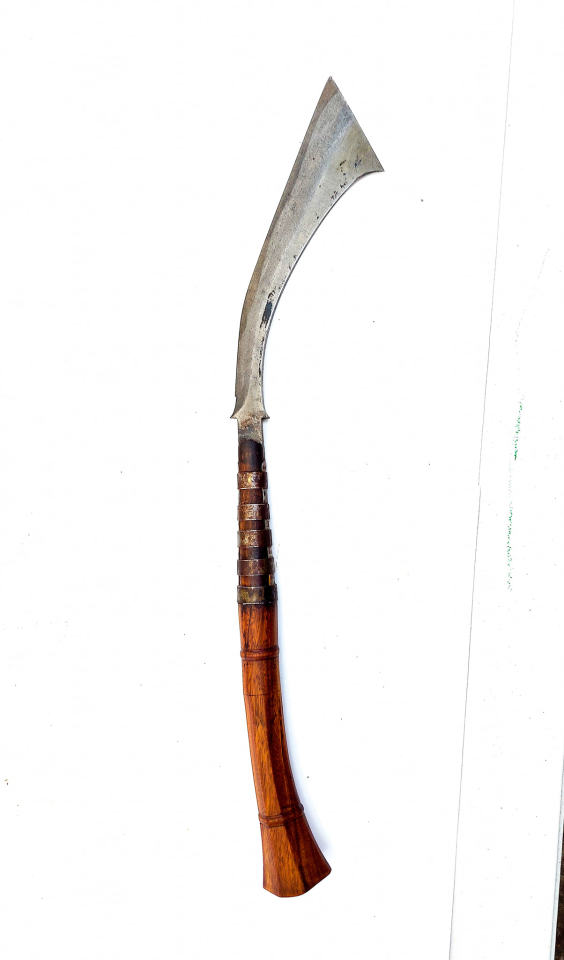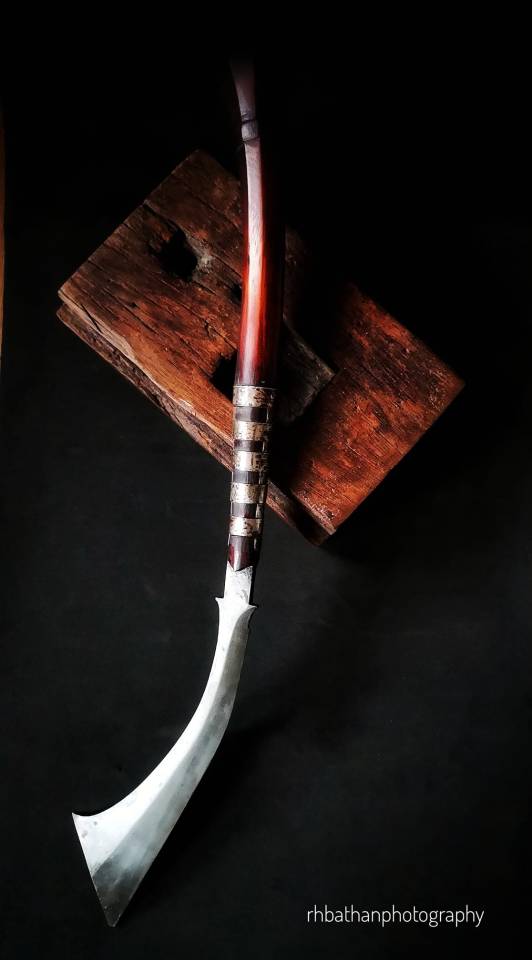Panabas - Tumblr Posts
The Fourth Blade: Panabas - "For Chopping"
Four days to the launch of the white-hot lightning that is the Gubat Banwa Kickstarter! Gubat Banwa is a TTRPG supported by the twin pillars of tactical martial arts and contemplative war drama. Meditate upon love and violence as warriors of a burning world. Will you stem the tide of blades? Or is it rising by your will?

I'll be posting the weapons I've drawn for the game as a countdown until the launch on October 10. This was supposed to be a Swordtember series, but we needed a little more time to gain momentum. 4/7 blades, past the halfway point, let us proceed with the PANABAS

Towering amongst what blade collectors categorize as "Moro weaponry", the panabas is quite possibly the largest blade I've ever drawn. Like- I'm not lying, I drew all the blades in this series to scale relative to each other, and the panabas has by and large been the one determining how big my canvas needs to be. The edge is on the longer curve, the spine of the blade is thicker near the handle, and the handle is about as long as the blade (if not longer).

(Photo from Kristian Josef Acedo)
The form belies the function; it isn't difficult to guess how this blade is used just by looking at it. The name- if I'm not mistaken- is an even bigger giveaway. Panabas supposedly comes from "pang-tabas" which literally means "for chopping". It also goes by the name of nawi.


(Photos from Raymundo Lucero) As large as its reputation might be, the choppers aren't always massive. Their utility ranges from agricultural to combative to ceremonial, and the size and shape usually matched the nature of the work.

(Tools from Datu Paglas, Maguindanao)

(Photo from Dondon Dimpas)

(Exhibit at Museum of the Filipino People- biggest one) The panabas is most often attributed to the peoples of Maguindanao, though the range of its use and the variants of its make span across large portions of the Mindanao area.

(Antiques from the collection of Richard Hudson, size comparison with a kalis) A popular tale (especially amongst Filipino Martial Artists) states that the US Marines wore leather collars to protect their necks during the American Occupation in Mindanao, due to blades like these that gave the troops pause, and feel that the extra protection was necessary. Supposedly, this is where the term "leatherneck" came from. Although the veracity of this latter claim is a bit on par with the claim that the Colt .45 was invented specifically to stop the same Moro warriors, the story has already stuck.

(Antique from Lake Lanao)

(Photo from The Metropolitan Museum of Art) We touched upon "Traditional" blades last time, referring to blades made by the same people to whose cultures those blades belong. This time we look at the other side of the coin. "Modern" is the term collectors here often use to refer to reinterpretations, usually by modern smiths who are separate from where a blade traditionally belongs. The point of reference I used for "Traditional" blades before is a katana forged by a traditional Japanese swordsmith. If- instead- a white blacksmith in America were to forge a katana using their own smithing methods, that would be considered as a "Modern" blade under this categorization. I'll leave it to you to spot the differences in these next few photos:

Traditional panabas with a rattan ferrule (Photo from Lorenz Lasco)

Modern blades by Jun Deuna (Espanola) and RE Pandayan (Quezon) (Photo from Dennis Andrew Golez)

Traditional blades (Marawi and Maguindanao) (Photo from Dennis Andrew Golez)

Modern full-tang build by Traditional Filipino Weapons (I know who forged this but I won't doxx their location) (Photo from the TFW website)

Modern full-tang build by Batangas Armory (Batangas) (Photo from Job Abat)

Pair of panabas and a binuaya (leftmost) by Traditional Moro Blade, Maguindanaon (Maguindanao)
Say it with me this time! Blade culture is alive and still developing. Mindanao was never conquered by Spain- the fierce resistance of the Moros made sure of that- and again it shows in the blade cultures. Though the panabas is now popular enough to have modern reinterpretations made by smiths across the Philippines, the traditional panabas and the people who make them are still around.

(Photo from Iniingatang Talim at Kaluban, taken by Ramon H. Bathan)
One of the Five Major Mahamandalas of Gubat Banwa pays homage to and gleans inspiration from living cultures like those I mentioned here. Yes- I repeated the text from the previous installment, because it's equally true, here. Additionally, the panabas shows up as the iconic weapon of the Martyr- one of the 25 Disciplines (read: "character classes") whose moon-bright martial techniques you could pick up in-game. Anyway, go check out the Kickstarter!
The Gubat Banwa Kickstarter launches in 4 days! Check it out here:

Not long now- this is a very small team of creators from the global south knocking on your doors asking for help to get the word out. I truly cannot understate how small this team is, and how amazing it is that they've come this far- we just need a little bit of a boost! With your help, this grand ambition can be realized. We would greatly appreciate any help rendered towards getting more eyes on this game!
Seven Blades Until Glory
Gubat Banwa launches on Kickstarter TODAY! Just a few more hours before the highly-anticipated launch of this award-winning, SEA fantasy-based, tactical martial arts TTRPG. Godsfuck, that's a lotta adjectives.

I've been posting the weapons I've drawn for the game to count down the final week before the launch. These were supposed to be for Swordtember but we had to move it back a little bit.

Below are links to all the individual threads, providing details on each of these individual blades, including which cultures they belong to and how they might have been (and still are) used.







The Gubat Banwa Kickstarter launches in a few hours! Check it out here:
